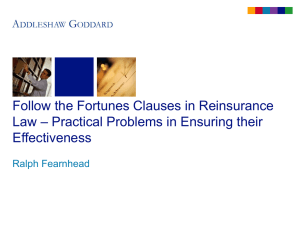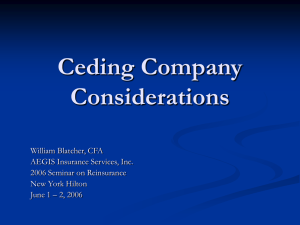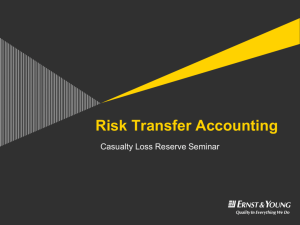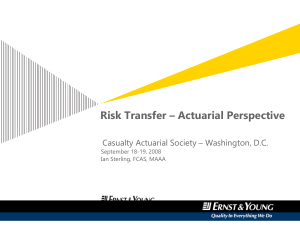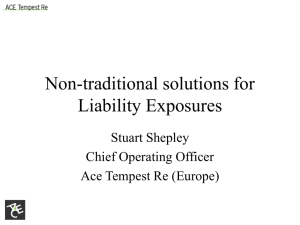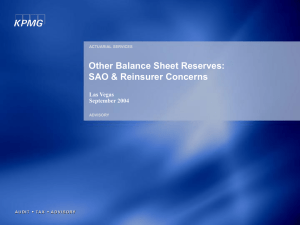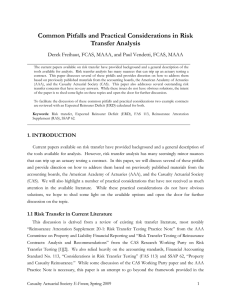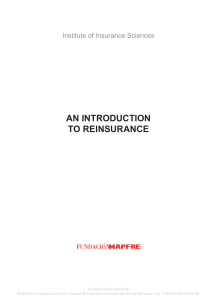Concurrent Simulation of a Reinsurance Market Price Cycle Don Mango (Guy Carpenter)
advertisement
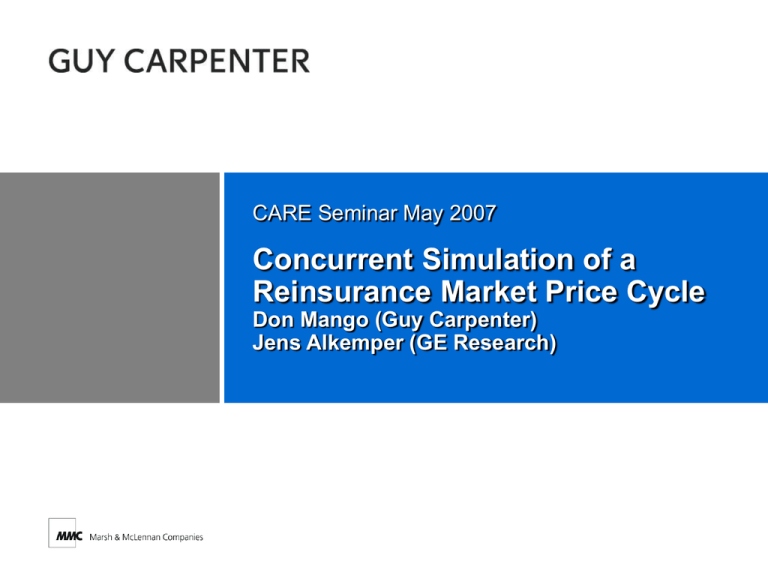
CARE Seminar May 2007 Concurrent Simulation of a Reinsurance Market Price Cycle Don Mango (Guy Carpenter) Jens Alkemper (GE Research) 2 Modeling the Pricing Cycle Can we replicate this price cycle using just basic assumptions? Construct a simplified reinsurance market, with core dynamics sufficiently realistic to ensure meaningful learning. The characteristics we chose to model are : – Single product type with known expected cost; – Single, known claims payment timing pattern; – Underwriting capacity measured, and pricing determined, as a function of underlying exposure units. An “idealized market” 3 Agent-Based Modeling – Reinsurer Agents aka “The Sims” Reinsurance is underwritten into a Book of Business. Premiums received in year one, loss paid equally over four years. Each Book collects premiums and generates claims. Price depends on the market conditions, but the break-even price is fixed at $400 per policy, the expected loss cost. As it is written, the following variables are established: number of exposure units (i.e., capacity underwritten), price per exposure unit, and expected claims (loss costs) per exposure unit. Premium (revenue) = exposures * price per exposure unit Total ultimate loss payments = exposures * claims per exposure unit As the book ages, it establishes a reserve liability A Reinsurer (the business) holds a collection of books of business by age, known as a portfolio. Reinsurer has assets and liabilities. The liabilities are the sum of the reserve liabilities for the books in the portfolio. The assets increase for premium, and decrease for expenses and claims payments. The difference between assets and liabilities is the capital. 4 Agent-Based Modeling – Reinsurer Agents aka “The Sims” Business Liability side Liabilities P rice E xpectedC laimsP erU nitE xposure Reinv estmentDecision C apital RequiredReserv eC apital BooksO fBusiness* M aximumE xposureD ollars A sset side premiums A ssets claims randomness N ew E xposureD ollarCap expenseLoad claimsM anagementCost 5 Market Dynamics Three reinsurers, no new entrants The model assumes that each of the three reinsurer’s bids the Underwriting capacity constrained maximum exposure units allowed by maximum capital adequacy ratio subject to its maximum CAR. = exposures / capital Bidding is simultaneous and blind Capped at 200% – each reinsurer knows only its own bid. This constrains their offered capacity The resulting market price is a Once a year each reinsurer will be asked for its offered capacity (expressed in exposure units = number of policies) Only one product type is available, with known expected loss cost of $400 per exposure unit. function of the aggregate capacity offered by all three agents combined, and is revealed after the bids are submitted. A simple demand curve is used to determine this market price. 6 Running the Market Initialization phase, each reinsurer is given some assets and a starting Book of Business. However, these are not in equilibrium. At period 60, we introduce a catastrophe that wipes out ~20% of the capital of each reinsurer. We observe what happens to the prices over the next 20 years. 600 550 500 price [$] We allowed 60 cycles of ramp-up for the market to reach a quasi-stable state Simulated price cycles 450 400 350 300 50 55 60 65 year 70 75 80 7 Observations The demand curve slope around the $400 (break-even cost) price influences the degree of damping observed. By modifying the demand curve, one can create scenarios in which price fluctuations escalate over time or are dampened out. The critical insight: even with many simplifying assumptions (e.g., known expected loss cost), the interaction effects of the strategies themselves introduce cyclical market behavior. One could speculate that the relaxation of the simplifying assumptions would in all likelihood not act to dampen or reduce the cyclicality. 8 Enhancements – Three LOB’s, Interactive 9 Worthy of further development? Industry consortium? Under the CAS banner?

